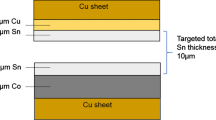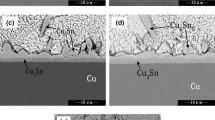Abstract
Cu6Sn5 and Cu3Sn intermetallic compounds are commonly found in the Sn-Cu bimetallic system. Due to the distinct resistivity of these two compounds, the electrical properties of Cu/Sn interfaces, e.g., solder joints on Cu metallization, may be impacted by the formation of Cu-Sn compounds. In this study, the kinetics of Sn-Cu compound formation was investigated by in-situ resistivity measurement, x-ray diffraction, and scanning electron microscopy (SEM). The interfacial reaction of the Cu-Sn bimetallic thin film specimen was monitored by the resistivity change of the specimen during thermal treatment. The activation energy of formation of Cu-Sn compounds was determined to be 0.97±0.07 eV. It is proposed that the Cu6Sn5 compound first forms at Sn/Cu interfaces and then reacts with Cu, forming the Cu3Sn compound at elevated temperatures during the thermal ramping process. The effect of thin film thickness on the sequential formation of Sn-Cu compounds is also discussed.
Similar content being viewed by others
References
K.N. Tu and K. Zeng, Mater. Sci. Eng. R 34, 1 (2001).
C.Y. Liu, K.H. Kim, K.N. Tu, and P.A. Totta, Appl. Phys. Lett. 69, 4014 (1996).
H.P.R. Frederikse, R.J. Fields, and A. Feldman, J. Appl. Phys. 72, 2879 (1992).
F. Stepniak, Microelectronics Reliability 41, 735 (2001).
Y.C. Chan, Alex C.K. So, and J.K.L. Lai, Mater. Sci. Eng. B55, 5 (1998).
C.Y. Liu, Chih Chen, K. Mal, and K.N. Tu, J. Appl. Phys. 85, 3882 (1999).
B.F. Dyson, T.R. Anthony, and D. Turnbull, J. Appl. Phys. 38, 3408 (1967).
K.N. Tu and R.D. Thompson, Acta Metall. 30, 947 (1982).
R. Chopra, M. Ohring, and R.S. Oswald, Thin Solid Films 94, 279 (1982).
K.N. Tu, Acta Metall. 21, 347 (1973).
R. Chopra and M. Ohring, Thin Solid Films 86, 43 (1981).
S. Dhabal and T.B. Ghosh, Appl. Surf. Sci. 211, 13 (2003).
W.W. So, S. Choe, R. Chuang, and C.C. Lee, Thin Solid Films 376, 164 (2000).
C.Y. Lee and K.L. Lin, Thin Solid Films 239, 93 (1994).
L.J. van der Pauw, Philips Technol. Rev. 20, 220 (1958).
H.K. Kim and K.N. Tu, Appl. Phys. Lett. 67, 2002 (1995).
K.N. Tu, J.M. Mayer, and L.C. Feldmann, Electronic Thin Film Science (New York: Macmillan, 1992), pp. 330–331.
K.N. Tu and J.W. Mayer, Thin Films-Interdiffusion and Reactions, eds. J.M. Poate, K.N. Tu, and J.W. Mayer (New York: Wiley, 1978), pp. 359–405.
Author information
Authors and Affiliations
Rights and permissions
About this article
Cite this article
Liao, C.N., Wei, C.T. Effect of intermetallic compound formation on electrical properties of Cu/Sn interface during thermal treatment. J. Electron. Mater. 33, 1137–1143 (2004). https://doi.org/10.1007/s11664-004-0115-9
Received:
Accepted:
Issue Date:
DOI: https://doi.org/10.1007/s11664-004-0115-9




